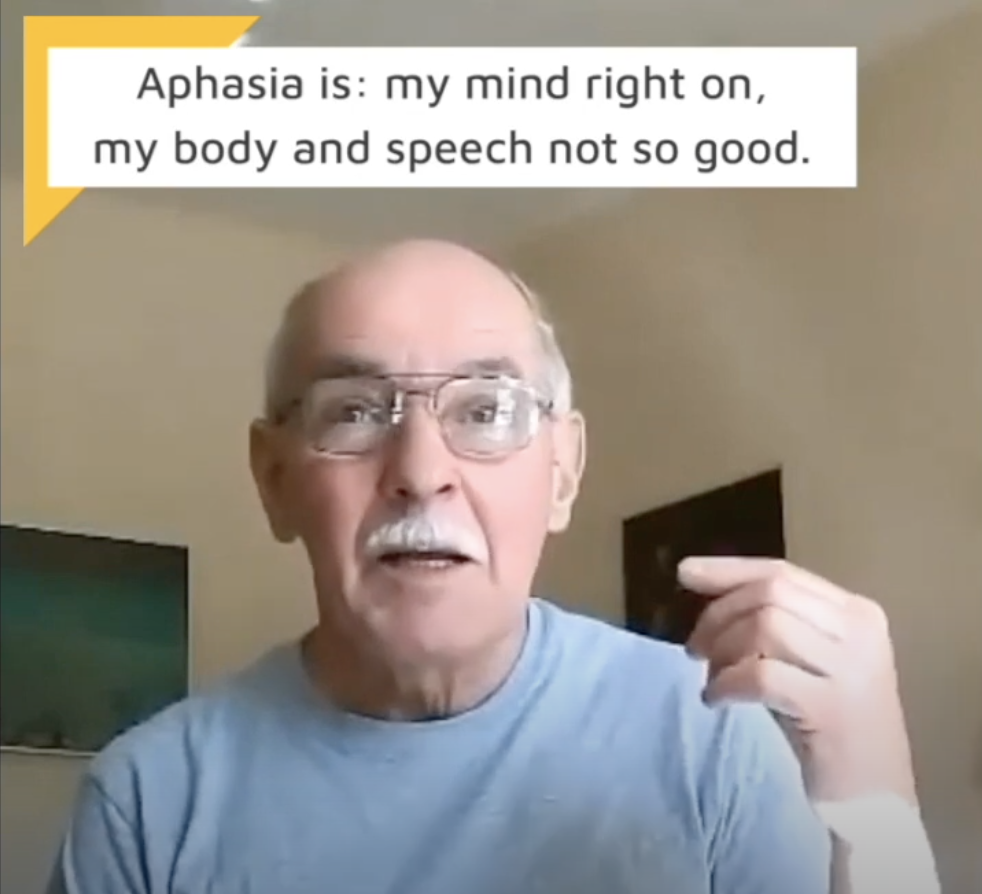UAlberta speech-language pathologist improving community accessibility for people with aphasia
Amanda Anderson - 19 November 2020

Aphasia is the loss of ability to understand or express speech as a result of brain damage, which can happen after a stroke or traumatic brain injury. (Photo: screenshot from the Aphasia Communication Matters video)
We all would agree that we need to make spaces accessible to individuals with physical impairments, but what about those with communication challenges?
Thanks to the Stephanie Chipeur Accessibility Research Fund, one University of Alberta researcher is identifying the communication supports people with aphasia — a language impairment that affects more than 100,000 Canadians — might need to access goods and services in their communities.
Esther Kim, associate professor in the Faculty of Rehabilitation Medicine’s Department of Communication Sciences and Disorders says she started this research when she realized many people with aphasia often rely on others to help them with basic tasks — and she wants that to change.
“Imagine how hard it would be if you couldn’t go to an appointment or go shopping on your own because you had to rely on someone to communicate for you,” said Kim. “If we can just provide a bit of education and training to service providers, people with communication disorders would be able to become much more independent.”
The research fund, which Kim received in 2020, is named in honour of Stephanie Chipeur who suffered a spinal cord injury in 2014. At the time, Chipeur was a doctoral student in the Faculty of Law at McGill University. Her own rehabilitation journey inspired her to advocate for social inclusion to help structure the process of rehabilitation for others.
Successful recipients are provided a one-time research grant of $15,000 to $25,000 to develop a research project that focuses on social justice as it relates to accessibility, visitability or universal design.
“As speech-language pathologists, we’re trained to help people with communication impairments become better communicators — to use strategies, a device or a communication book to express themselves,” explained Kim. “But what if we could work on making the environment more accessible, much like they have done for people with physical impairments?”
Kim, who is collaborating with Department of Communication Sciences and Disorders Associate Lecturer Andrea Ruelling on the project, hopes that furthering this research will allow people with aphasia to have more of a say in what would be helpful to them.
“is it more time? Education? Resources? By getting input from these stakeholders, I hope that we will be able to apply this knowledge to the settings they would like to access, such as grocery stores, dentists’ offices, auto repair shops, et cetera.”
Right now, the project features two research partners, Herman Koo and Daralynn Swensrude, president of the The Communication Health, and Therapy (CHAT) Society who both live with aphasia due to traumatic brain injuries — Koo from a random shooting incident in 2018 and Swensrude from falling and hitting her head on ice in 2013.
“One of our key deliverables from the project, with the help of our research partners and study participants, will be a set of recommendations that business owners and service providers can access to help make their spaces more welcoming to those with speech challenges,” said Kim.
This project builds upon a previous pilot study that Kim, Ruelling and students in the speech-language pathology class of 2021 recently completed. Students interviewed people with aphasia to assess their needs for accessing retail services in the community.
“Students were able to work with participants to come up with strategies and resources while coaching them through in-person interactions at various businesses,” said Kim. “The businesses’ employees then completed a survey about their knowledge of aphasia and their confidence in communicating with individuals with communication impairments.
“Since the COVID-19 pandemic, we’ve also had to pivot the project and expectations a bit, creating an educational video to share with the general public about aphasia and communication strategies in the meantime.”
Once the project is complete, Kim hopes that those currently living with aphasia will receive the same kind of support from the community as those with physical disabilities do.
“We’re all familiar with the concept of a wheelchair ramp to help people with physical impairments access buildings. In this case, I hope to have some of the pieces in place to help implement ‘communication ramps,’ which would help those with communication disorders access the same environments with ease.”